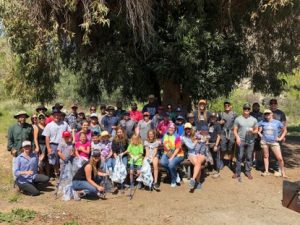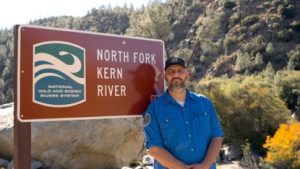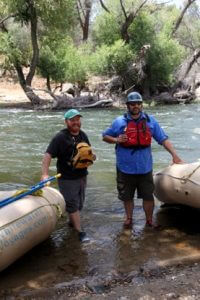Kern River Conservancy: Building the Next Generation of Wild & Scenic River Protectors
 “I tell people that River Rally changed my life,” laughs Gary Ananian, Executive Director and Founder of Kern River Conservancy. A first-time attendee of River Network’s River Rally (held near Truckee, California in April/May 2018), Ananian came to environmental work from a background in the food and beverage industry. The environmental community was all new to him, and he felt, admittedly, like a fish out of water. “When I first got to River Rally [in April 2018], I was intimidated. I was just a dude from a nightclub picking up trash,” Ananian explains, “I wondered, ‘What do I have to offer?’”
“I tell people that River Rally changed my life,” laughs Gary Ananian, Executive Director and Founder of Kern River Conservancy. A first-time attendee of River Network’s River Rally (held near Truckee, California in April/May 2018), Ananian came to environmental work from a background in the food and beverage industry. The environmental community was all new to him, and he felt, admittedly, like a fish out of water. “When I first got to River Rally [in April 2018], I was intimidated. I was just a dude from a nightclub picking up trash,” Ananian explains, “I wondered, ‘What do I have to offer?’”
During Ananian’s presentation on Millennial Engagement on Wild and Scenic Rivers at this year’s River Rally, it was clear that when it comes to volunteer recruitment, Ananian and the Kern River Conservancy have a lot to share. “We typically have seventy to eighty or ninety volunteers showing up for events,” Ananian says. “A lot of groups have problems getting volunteers to show up. One reason is that they don’t understand that youth—millennials—want to have fun. Nobody wants to come hold the clipboard.”
Holding the clipboard is how Ananian first started KRC’s volunteer outreach program five years ago when he founded Kern River Conservancy, an environmental group dedicated to protecting the Kern River, a watershed with 151 miles of Wild and Scenic designation. The Kern River is within a four-hour drive of more than a third of southern California’s population, yet mention it to most southern Californians and they have no idea it exists. It didn’t take Ananian long to recognize that the clipboard and other traditional outreach tactics blocked him from connecting with people already enjoying the river and reaching those who don’t yet know about the Kern, a river that flows west from California’s highest peak, Mt. Whitney, with remarkable public access and recreational value.
“I have 15 years’ experience in bars and nightclubs in Los Angeles, with training in customer service, talking to people and relating to their needs,” Ananian explains, “In customer service, we’re always asking, ‘What can we do to make their experience better next time? What do they want and expect?’” He ditched the clipboard and pretended he was at the bar.
 “Relating to people is key,” says Ananian, who is of Armenian descent. “When you speak to people, especially when engaging with Latinos and multi-cultural groups, you find out they really want to help. Most of these groups see the Forest Service and other environmental groups as enforcement and I didn’t want to appear that way. Eighty percent of our volunteer base is Latino. People want to get involved, it doesn’t matter about race, it matters how the organization or agency presents itself. If it’s only white people doing outreach or in the brochure materials or social media, it’s going to be a struggle to recruit minorities.”
“Relating to people is key,” says Ananian, who is of Armenian descent. “When you speak to people, especially when engaging with Latinos and multi-cultural groups, you find out they really want to help. Most of these groups see the Forest Service and other environmental groups as enforcement and I didn’t want to appear that way. Eighty percent of our volunteer base is Latino. People want to get involved, it doesn’t matter about race, it matters how the organization or agency presents itself. If it’s only white people doing outreach or in the brochure materials or social media, it’s going to be a struggle to recruit minorities.”
Equity, diversity, and inclusion (EDI) is an intentional focus for the Kern River Conservancy, from diversity of the board to informational Spanish-language commercials filmed by the KRC and aired on local networks. “People need to know it’s for everyone. They want to be comfortable, feel welcome. Not like they’re part of a quota,” Ananian says. “I want everyone to know this is their river and it belongs to them.”
Ananian credits KRC’s Instagram feed with growing their volunteer base so quickly, attracting Angelenos to the Kern River with fun, splashy videos of rafting trips that emphasize trash and graffiti clean-up. “Everyone wants to be a part of it,” says Ananian. He admits, however, that Instagram can bring a negative impact in the form of over-exposing the river and surrounding forest. A recent post about a local hot springs prompted over a thousand inquiries about the location. That’s why, in all posts, KRC strives to include vital environmental messaging. “It’s a tough decision for any group working to protect wild rivers, walking that line, but we started Kern River Conservancy because we wanted to take care of the river.”
 Helping to foster awareness of the issues facing the Kern is what prompted the Kern River Conservancy to organize the first Kern River Wild and Scenic Film Festival in November, to celebrate the 50th anniversary of the Wild and Scenic Rivers Act and the 31st anniversary of the Kern’s designation as a Wild and Scenic River. The festival will showcase a new beer brewed by Kern River Brewing Company and several films about the Kern, including one produced by the Kern River Conservancy. “We want to show what people went through to get the Kern River designated,” Ananian says, “and bring awareness to the Lower Kern and the current efforts to get it designated Wild and Scenic.”
Helping to foster awareness of the issues facing the Kern is what prompted the Kern River Conservancy to organize the first Kern River Wild and Scenic Film Festival in November, to celebrate the 50th anniversary of the Wild and Scenic Rivers Act and the 31st anniversary of the Kern’s designation as a Wild and Scenic River. The festival will showcase a new beer brewed by Kern River Brewing Company and several films about the Kern, including one produced by the Kern River Conservancy. “We want to show what people went through to get the Kern River designated,” Ananian says, “and bring awareness to the Lower Kern and the current efforts to get it designated Wild and Scenic.”
The Kern is a river that intertwines with more people than most, yet maintains its wild character, thanks to the efforts of environmentalists who worked to see it protected and citizens like Ananian who remain committed. “I don’t know a lot about ecology because I’m not educated as a scientist. I try to learn what I can,” reflects Ananian. “But what I do bring is an inspiring story of getting involved and taking a stand. That outweighs everything else. After all the calls and emails I received [from River Rally] asking for help, I was so proud of what I was able to accomplish. I feel part of the team.”




